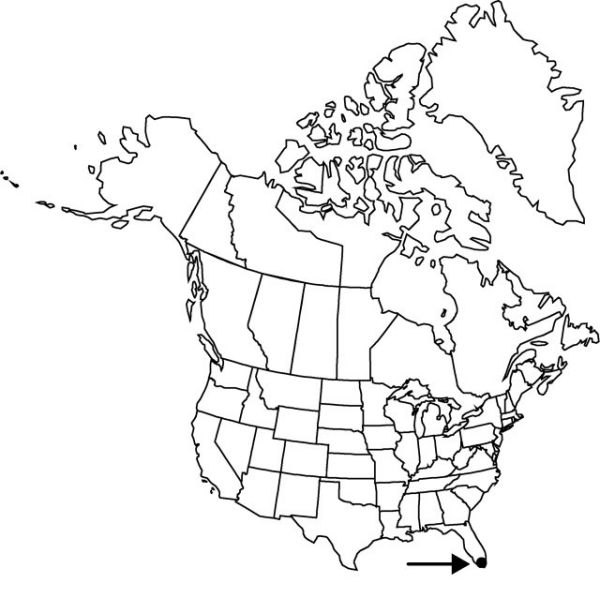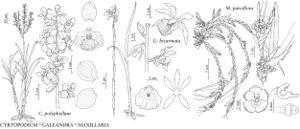Difference between revisions of "Cyrtopodium polyphyllum"
Acta Bot. Brasil. 8: 12. 1994.
FNA>Volume Importer |
imported>Volume Importer |
||
| (6 intermediate revisions by 2 users not shown) | |||
| Line 7: | Line 7: | ||
|year=1994 | |year=1994 | ||
}} | }} | ||
| − | |basionyms={{Treatment/ID/ | + | |special_status={{Treatment/ID/Special_status |
| + | |code=I | ||
| + | |label=Introduced | ||
| + | }}{{Treatment/ID/Special_status | ||
| + | |code=F | ||
| + | |label=Illustrated | ||
| + | }} | ||
| + | |basionyms={{Treatment/ID/Basionym | ||
|name=Epidendrum polyphyllum | |name=Epidendrum polyphyllum | ||
|authority=Vellozo | |authority=Vellozo | ||
| + | |rank=species | ||
| + | |publication_title=Fl. Flumin., plate vol. | ||
| + | |publication_place=9, 17. 1831 | ||
}} | }} | ||
|synonyms={{Treatment/ID/Synonym | |synonyms={{Treatment/ID/Synonym | ||
|name=Cyrtopodium paranaense | |name=Cyrtopodium paranaense | ||
|authority=Schlechter | |authority=Schlechter | ||
| + | |rank=species | ||
}} | }} | ||
|hierarchy=Orchidaceae;Orchidaceae subfam. Epidendroideae;Orchidaceae tribe Cymbidieae;Orchidaceae (tribe Cymbidieae) subtribe Cyrtopodiinae;Cyrtopodium;Cyrtopodium polyphyllum | |hierarchy=Orchidaceae;Orchidaceae subfam. Epidendroideae;Orchidaceae tribe Cymbidieae;Orchidaceae (tribe Cymbidieae) subtribe Cyrtopodiinae;Cyrtopodium;Cyrtopodium polyphyllum | ||
| Line 29: | Line 40: | ||
|elevation=10–100[–1500] m | |elevation=10–100[–1500] m | ||
|distribution=Fla.;South America (Brazil). | |distribution=Fla.;South America (Brazil). | ||
| − | |discussion=<p>Cyrtopodium polyphyllum was reported for Florida (C. A. Luer 1972) as C. andersonii (Lambert) R. Brown. The only available herbarium specimen [McCormack sub G. N. Avery 1155 (FTG)] is referable to C. polyphyllum. Cyrtopodium andersonii differs from C. polyphyllum in having narrowly ovate rather than broadly elliptic sepals (G. A. Romero-G. and G. Carnevali F.-C. 1999).</p> | + | |introduced=true |
| + | |discussion=<p><i>Cyrtopodium polyphyllum</i> was reported for Florida (C. A. Luer 1972) as <i>C. andersonii</i> (Lambert) R. Brown. The only available herbarium specimen [McCormack sub G. N. Avery 1155 (FTG)] is referable to <i>C. polyphyllum</i>. <i>Cyrtopodium</i> andersonii differs from <i>C. polyphyllum</i> in having narrowly ovate rather than broadly elliptic sepals (G. A. Romero-G. and G. Carnevali F.-C. 1999).</p> | ||
|tables= | |tables= | ||
|references= | |references= | ||
| Line 38: | Line 50: | ||
-->{{#Taxon: | -->{{#Taxon: | ||
name=Cyrtopodium polyphyllum | name=Cyrtopodium polyphyllum | ||
| − | |||
|authority=(Vellozo) Pabst ex F. Barrios | |authority=(Vellozo) Pabst ex F. Barrios | ||
|rank=species | |rank=species | ||
| Line 53: | Line 64: | ||
|publication title=Acta Bot. Brasil. | |publication title=Acta Bot. Brasil. | ||
|publication year=1994 | |publication year=1994 | ||
| − | |special status= | + | |special status=Introduced;Illustrated |
| − | |source xml=https:// | + | |source xml=https://bitbucket.org/aafc-mbb/fna-data-curation/src/2e0870ddd59836b60bcf96646a41e87ea5a5943a/coarse_grained_fna_xml/V26/V26_1320.xml |
|subfamily=Orchidaceae subfam. Epidendroideae | |subfamily=Orchidaceae subfam. Epidendroideae | ||
|tribe=Orchidaceae tribe Cymbidieae | |tribe=Orchidaceae tribe Cymbidieae | ||
Latest revision as of 21:13, 5 November 2020
Plants terrestrial, 50–150 cm. Pseudobulbs elongate, fusiform. Inflorescences erect, racemes to panicles, 100–200 cm. Flowers bright yellow, 3–4 cm wide; lip with middle lobe margins not conspicuously verruculose-tuberculate, lateral lobes bright yellow, shorter than middle lobe. Capsules to 10 cm.
Phenology: Flowering winter.
Habitat: Pinelands
Elevation: 10–100[–1500] m
Distribution

Introduced; Fla., South America (Brazil).
Discussion
Cyrtopodium polyphyllum was reported for Florida (C. A. Luer 1972) as C. andersonii (Lambert) R. Brown. The only available herbarium specimen [McCormack sub G. N. Avery 1155 (FTG)] is referable to C. polyphyllum. Cyrtopodium andersonii differs from C. polyphyllum in having narrowly ovate rather than broadly elliptic sepals (G. A. Romero-G. and G. Carnevali F.-C. 1999).
Selected References
None.
